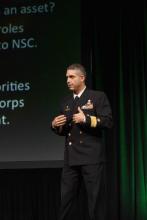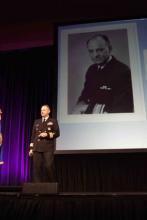User login
Dr. Clancy Outlines VA Blueprint for Change
Carolyn M. Clancy, MD, Interim Under Secretary for Health at the VA outlined strategic aims for reshaping and restructuring into a more unified veteran-focused health care system. The ultimate goal for the plan is to put the veteran in control of his or her health care by providing a single phone number, a website, and well-trained VA employees who understand all the VA’s offerings. According to Dr. Clancy, “[this restructuring's] success will be defined from the veteran’s perspective."
- Operate a health care network that anticipates and meets the needs of veterans;
- Deliver high-quality, veteran-centered care that compares favorably to private sector health care;
- Leverage information technology, analytics, and models of delivery to optimize health care;
- Grow an organizational culture rooted in the VA’s core values and mission and prioritize veterans;
- Foster an environment of continuous learning, responsible risk taking, and personal accountability;
- Advance a model of health care that is personalized, proactive, and patient-driven;
- Lead the nation in research and treatment of military service-related conditions;
- Support innovation in health services through academic affiliations;
- Operate and communicate with integrity, transparency, and accountability; and
- Modernize VA management, including human resources, accounting, and other support services.
An Update on the Defense Health Agency
The Assistant Secretary of Defense for Health Affairs Jonathan Woodson, MD, outlined the strategic challenges and plans for changes at the $50 billion Defense Health Agency (DHA). “Get ready, this train is going to move very fast and you are part of it,” he challenged active service health care providers. "We understand this is a complicated world, and we need to get energized to find the solutions.”
Dr. Woodson also promised to develop better telehealth capabilities. “Telehealth is going to be an important tool, because it gives us the capability to reach forward and reach back,” he said, “We are a highly distributed system, and we need to develop it as a system, not just as a technology.”
PHS Officials Discuss 50-Year Battle Against Tobacco Use
RADM Lushniak noted that the PHS became the first uniformed service to go tobacco-free while in uniform. Joining the Acting Surgeon General in the presentation was RADM David L. Ashley who discussed how the PHS eliminated tobacco use within its ranks. RADM Ashley outlined 10 guidelines for clinicians to support patients in battling a tobacco addiction.
CAPT Kimberly Elenberg also outlined the steps PHS is taking to help the other uniformed services in their efforts to reduce and eliminate tobacco use. According to CAPT Elenberg, it is essential to recognize the specific and unique deployment challenges that active service members face and the rationales behind tobacco use before being able to reduce its use.
For more information on the 2014 AMSUS Annual Continuing Education Meeting, visit http://amsusmeetings.org/annual-meeting.
Dr. Clancy Outlines VA Blueprint for Change
Carolyn M. Clancy, MD, Interim Under Secretary for Health at the VA outlined strategic aims for reshaping and restructuring into a more unified veteran-focused health care system. The ultimate goal for the plan is to put the veteran in control of his or her health care by providing a single phone number, a website, and well-trained VA employees who understand all the VA’s offerings. According to Dr. Clancy, “[this restructuring's] success will be defined from the veteran’s perspective."
- Operate a health care network that anticipates and meets the needs of veterans;
- Deliver high-quality, veteran-centered care that compares favorably to private sector health care;
- Leverage information technology, analytics, and models of delivery to optimize health care;
- Grow an organizational culture rooted in the VA’s core values and mission and prioritize veterans;
- Foster an environment of continuous learning, responsible risk taking, and personal accountability;
- Advance a model of health care that is personalized, proactive, and patient-driven;
- Lead the nation in research and treatment of military service-related conditions;
- Support innovation in health services through academic affiliations;
- Operate and communicate with integrity, transparency, and accountability; and
- Modernize VA management, including human resources, accounting, and other support services.
An Update on the Defense Health Agency
The Assistant Secretary of Defense for Health Affairs Jonathan Woodson, MD, outlined the strategic challenges and plans for changes at the $50 billion Defense Health Agency (DHA). “Get ready, this train is going to move very fast and you are part of it,” he challenged active service health care providers. "We understand this is a complicated world, and we need to get energized to find the solutions.”
Dr. Woodson also promised to develop better telehealth capabilities. “Telehealth is going to be an important tool, because it gives us the capability to reach forward and reach back,” he said, “We are a highly distributed system, and we need to develop it as a system, not just as a technology.”
PHS Officials Discuss 50-Year Battle Against Tobacco Use
RADM Lushniak noted that the PHS became the first uniformed service to go tobacco-free while in uniform. Joining the Acting Surgeon General in the presentation was RADM David L. Ashley who discussed how the PHS eliminated tobacco use within its ranks. RADM Ashley outlined 10 guidelines for clinicians to support patients in battling a tobacco addiction.
CAPT Kimberly Elenberg also outlined the steps PHS is taking to help the other uniformed services in their efforts to reduce and eliminate tobacco use. According to CAPT Elenberg, it is essential to recognize the specific and unique deployment challenges that active service members face and the rationales behind tobacco use before being able to reduce its use.
For more information on the 2014 AMSUS Annual Continuing Education Meeting, visit http://amsusmeetings.org/annual-meeting.
Dr. Clancy Outlines VA Blueprint for Change
Carolyn M. Clancy, MD, Interim Under Secretary for Health at the VA outlined strategic aims for reshaping and restructuring into a more unified veteran-focused health care system. The ultimate goal for the plan is to put the veteran in control of his or her health care by providing a single phone number, a website, and well-trained VA employees who understand all the VA’s offerings. According to Dr. Clancy, “[this restructuring's] success will be defined from the veteran’s perspective."
- Operate a health care network that anticipates and meets the needs of veterans;
- Deliver high-quality, veteran-centered care that compares favorably to private sector health care;
- Leverage information technology, analytics, and models of delivery to optimize health care;
- Grow an organizational culture rooted in the VA’s core values and mission and prioritize veterans;
- Foster an environment of continuous learning, responsible risk taking, and personal accountability;
- Advance a model of health care that is personalized, proactive, and patient-driven;
- Lead the nation in research and treatment of military service-related conditions;
- Support innovation in health services through academic affiliations;
- Operate and communicate with integrity, transparency, and accountability; and
- Modernize VA management, including human resources, accounting, and other support services.
An Update on the Defense Health Agency
The Assistant Secretary of Defense for Health Affairs Jonathan Woodson, MD, outlined the strategic challenges and plans for changes at the $50 billion Defense Health Agency (DHA). “Get ready, this train is going to move very fast and you are part of it,” he challenged active service health care providers. "We understand this is a complicated world, and we need to get energized to find the solutions.”
Dr. Woodson also promised to develop better telehealth capabilities. “Telehealth is going to be an important tool, because it gives us the capability to reach forward and reach back,” he said, “We are a highly distributed system, and we need to develop it as a system, not just as a technology.”
PHS Officials Discuss 50-Year Battle Against Tobacco Use
RADM Lushniak noted that the PHS became the first uniformed service to go tobacco-free while in uniform. Joining the Acting Surgeon General in the presentation was RADM David L. Ashley who discussed how the PHS eliminated tobacco use within its ranks. RADM Ashley outlined 10 guidelines for clinicians to support patients in battling a tobacco addiction.
CAPT Kimberly Elenberg also outlined the steps PHS is taking to help the other uniformed services in their efforts to reduce and eliminate tobacco use. According to CAPT Elenberg, it is essential to recognize the specific and unique deployment challenges that active service members face and the rationales behind tobacco use before being able to reduce its use.
For more information on the 2014 AMSUS Annual Continuing Education Meeting, visit http://amsusmeetings.org/annual-meeting.



